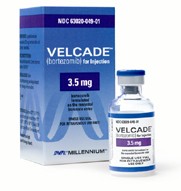
Recently Diagnosed or Relapsed? Stop Looking For a Miracle Cure, and Use Evidence-Based Therapies To Enhance Your Treatment and Prolong Your Remission
Multiple Myeloma an incurable disease, but I have spent the last 25 years in remission using a blend of conventional oncology and evidence-based nutrition, supplementation, and lifestyle therapies from peer-reviewed studies that your oncologist probably hasn't told you about.
Click the orange button to the right to learn more about what you can start doing today.
- You are here:
- Home »
- Blog »
- Multiple Myeloma »
- Velcade Side Effects
Velcade Side Effects

Velcade aka bortezomib is an effective chemotherapy regimen for myeloma but velcade side effects can cause problems for MM patients.
The article linked and excerpted below offers a based dose timing solution. The PeopleBeatingCancer archives offer other possible solutions.
I am a long-term MM survivor living with a host of long-term and late stage side effects. While I won’t say that short, long-term and late stage side effects are more important than living (length vs. quality of life), I will say that oncology gives little attention to side effects and changes the standard-of-care therapy plan only if the MM patient experiencing the side effect, complains loudly.
Which side effects are most commonly associated with velcade/bortezomib?
- Peripheral neuropathy: This is a condition characterized by damage to the nerves, often causing tingling, numbness, or pain in the hands and feet. Peripheral neuropathy is one of the most common side effects of Velcade, although it is often manageable and reversible with dose adjustments or discontinuation of the medication.
- Fatigue: Feeling tired or lacking energy is a common side effect of many cancer treatments, including Velcade.
- Gastrointestinal disturbances: Nausea, vomiting, diarrhea, and constipation are common gastrointestinal side effects associated with Velcade.
- Thrombocytopenia: A decrease in the number of platelets in the blood, which can increase the risk of bleeding. Close monitoring of blood counts is necessary during Velcade treatment.
- Neutropenia: A decrease in the number of neutrophils, a type of white blood cell that helps fight infections. Neutropenia can increase the risk of infections.
- Anemia: A decrease in the number of red blood cells, which can lead to fatigue and shortness of breath.
- Fever: Some patients may experience fever as a side effect of Velcade treatment.
As the study below points out, two basic changes to how velcade is administered, can make a measurable difference to a common adverse event called chemotherapy-induced peripheral neuropathy (CIPN).
- Subcutaneous, not intravenous and
- Administration once a week not twice a week-
If the MM patient is willing to consider evidence-based but non-conventional, non-FDA approved therapies cited to reduce the risk of side effects, also consider:
- Curcumin- “Here we show that the water-soluble analog of curcumin #12, but not curcumin, in combination with bortezomib could enhance the proteasome-inhibitory effect in multiple myeloma cells…”
- Omega-3 fatty acids- “Using a combination treatment of docosahexaenoic acid (DHA) or eicosapentaenoic acid (EPA) and bortezomib, it was demonstrated previously that pretreatment with DHA/EPA significantly increased bortezomib chemosensitivity in MM cells..”
- Resveratrol- “RSV enhanced the sensitivity of H929R cells against BTZ via inhibition of cell viability and colony formation, induction of cell apoptosis and regulation of expression of apoptosis-related proteins..”
- CBD oil- “These results showed that CBD by itself or in synergy with BORT strongly inhibited growth, arrested cell cycle progression and induced MM cells death by regulating the ERK, AKT and NF-κB pathways with major effects in TRPV2+ cells…”
- Pterostilbne- “In conclusion, our findings suggest that the anti-myeloma activity of Pter in the bortezomib-resistant line H929R involves inhibition of cell proliferation, apoptosis induction, and S-phase arrest…”
- Honokiol- Furthermore, HNK enhances MM cell cytotoxicity and apoptosis induced by bortezomib…”
- Tymoquinone- “Furthermore, in a xenograft mouse model, TQ potentiated the antitumor effects of bortezomib (p<0.05, vehicle versus bortezomib + TQ; p<0.05, bortezomib versus bortezomib + TQ), and this correlated with modulation of various markers for survival and angiogenesis…”
- Acupuncture- “In summary, this study demonstrates the synergistic effects of acupuncture and bortezomib on extending the survival of MM model mice…”
Admittedly, the studies excerpted above are not clinical trials. As such, conventional oncology will undoubtedly dismiss them and the information about non-toxic therapies shown to enhance velcade/bortizomib while possibly reducing its velcade side effects.
The challenge faced by all MM patients and survivors is that all chemo regimens eventually lose their effectiveness against myeloma and and all chemo regimens can cause side effects.
Are you a newly diagnosed myeloma patient? Or have you recently relapsed and are wondering about your future therapies? If you’d like to learn more about managing multiple myeloma email me at David.PeopleBeatingCancer@gmail.com
I look forward to hearing from you. Hang in there.
David Emerson
- MM Survivor
- MM Cancer Coach
- Director PeopleBeatingCancer
Once-weekly versus twice-weekly bortezomib in newly diagnosed multiple myeloma: a real-world analysis
“Induction regimens for multiple myeloma (MM) commonly include bortezomib, which has typically been administered twice weekly despite studies demonstrating comparable efficacy and less peripheral neuropathy (PN) with once-weekly bortezomib.
We aimed to analyze the real-world prevalence and efficacy of once-weekly versus twice-weekly bortezomib regimens in newly diagnosed MM…
Real-world progression-free survival (median 37.2 months with once-weekly versus 39.6 months with twice-weekly) and overall survival (medians not reached in either cohort,) were comparable.
PN rates were higher in patients receiving twice-weekly bortezomib (34.7% versus 18.5%).
In conclusion, once-weekly bortezomib is clearly associated with similar efficacy and fewer toxicities compared to twice-weekly bortezomib. Our findings support once-weekly bortezomib as a standard-of-care regimen for newly diagnosed patients with MM…
As shown in Fig. 3A, there was no statistically significant difference in rwPFS among patients receiving once-weekly (median 37.2 months, 95% CI 33.1–42.4 months) versus twice-weekly bortezomib (median 39.6 months, 95% CI 33.2-46.1 months)…
As shown in Fig. 3B, there was also no statistically significant difference in rwOS with median 27.1 months follow-up. Median rwOS was not reached in either group, with a HR 0.90 [95% CI 0.75–1.08].
The cumulative neuropathy rate, encompassing any PN diagnosis or initiation of medications for neuropathy was 24.4% overall.
As shown in Table 1, PN was significantly more common with twice-weekly bortezomib than once-weekly bortezomib (34.7% versus 18.5%…
Compared to its initial administration in SWOG S0777 and other early trials, bortezomib has largely shifted from intravenous to subcutaneous dosing based on the results of non-randomized analyses showing similar efficacy with fewer toxicities [28]…
In conclusion, this study supports the incorporation of once-weekly bortezomib into standard-of-care regimens for newly diagnosed patients with MM.
Just as with non-randomized comparisons of subcutaneous versus intravenous bortezomib, once-weekly bortezomib is associated with equivalent outcomes and a more favorable side-effect profile compared to twice-weekly dosing.
More broadly, once-weekly bortezomib not only reduces the clinical burden of care by reducing visit frequency but may likely be more cost-effective as well.”


